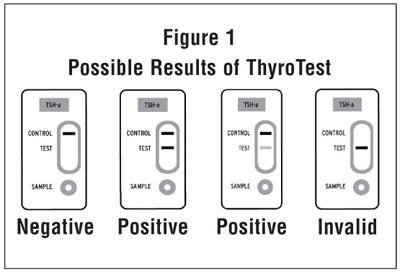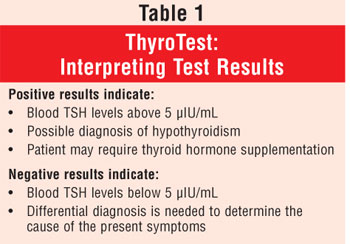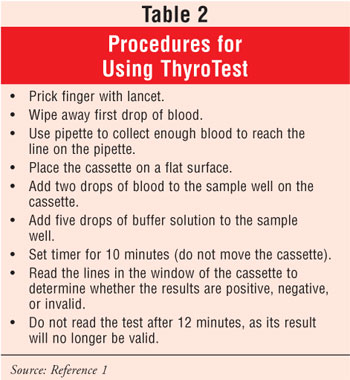US Pharm. 2006;1:58-62.
Hypothyroidism is a condition in which the thyroid gland does not produce enough thyroid hormones. Thyroid hormones are responsible for many of the body's metabolic functions. Hypothyroidism's incidence increases with age, particularly among women; one out of eight women will develop the condition. Moreover, it is estimated that 13 million people remain undiagnosed.1
Pathophysiology
Primary hypothyroidism usually results from Hashimoto's disease, an autoimmune disorder that attacks the thyroid gland. Antibodies are directed against the antigens on thyroid cell membranes and the thyroid peroxidase enzyme, resulting in the activation of complement proteins and ultimately killing thyroid cells. This decreases the circulating levels of triiodothyronine (T3) and thyroxine (T4), thereby contributing to an increase in the levels of thyroid-stimulating hormone (TSH). Other causes of primary hypothyroidism include surgery, exposure to radiation, and iodine deficiency.2
Diagnosis
Diagnosis of hypothyroidism is determined through laboratory tests for TSH levels, free T4 levels, and circulating antithyroid antibodies. TSH levels are increased in primary hypothyroidism, while T4 levels are decreased. If the patient has Hashimoto's disease, antibodies can also be present. 3
Signs and symptoms of hypothyroidism include an enlarged thyroid gland, weight gain, dry skin, cold intolerance, depression, constipation, weakness, fatigue, hair loss, muscle cramps, brittle fingernails, heavy menstrual periods, and problems with memory and concentration.1
ThyroTest
Developed by ThyroTec, ThyroTest is an FDA-approved device that measures the level of TSH in the blood and is performed at the physician's office. It measures levels of TSH above 5 µIU/mL. Since TSH rises above this level when thyroid hormone levels are low, this device is an excellent screening tool in the diagnosis of primary hypothyroidism.4
Similar to a home pregnancy test, ThyroTest has a control window and a test window. Drops of blood and buffer solution should be added to the sample well on the cassette. After approximately 10 minutes, results may be interpreted. For a positive reading, a pink/purple line should appear near the cassette's test and control marks, indicating a TSH level greater than 5 µIU/mL. As long as the line forms, the result is positive; it does not matter how intense the line appears. For negative results, only the line near the control mark should be present ( FIGURE 1). The implications of a positive or negative test result are explained in TABLE 1.4

ThyroTest includes a quality control method to improve accuracy. For a valid test, the control solution must yield a pink/purple line near the control mark. If there is no line near the control mark, the test result is invalid and the cassette should not be used. Instead, another cassette from the same lot should be tested. If it is also inaccurate, the rest of the cassettes in that lot should not be used and the company should be contacted. Patient instructions are located in TABLE 2.4

Efficacy
ThyroTest was compared to a commercially available TSH assay. Results based on 289 clinical specimens showed 95.5% accuracy, 81.25% sensitivity, and 97.28% specificity for ThyroTest when compared to the assay. Precision was also determined using duplicate assays of samples from three different serum pools and kits from three different production lots. After each specimen sample was run through 10 parallel assays, the data demonstrated 100% precision within each individual lot and between the three different lots. Interference data were also determined using different drugs and hormones. Results showed that these substances did not interfere with ThyroTest TSH results.1

Conclusion
The ThyroTest is a quick and easy method that health care professionals can use to help diagnose hypothyroidism. The test is a simple three-step process that can be performed at the physician's office, without the need for laboratory analysis of the patient's blood. The test is highly accurate and can be stored at room temperature for up to 18 months.4 ThyroTest cannot be used to help diagnose hyperthyroidism (i.e., overactive thyroid), as it cannot detect the low or nonexistent levels of TSH associated with this condition.1 Also, the test is eligible for reimbursement through Medicare and Medicaid. 1
REFERENCES
1. Rapid Thyroid Stimulating Hormone Screen. Available at: www.thyrotest.com. Accessed October 17, 2005.
2. DiPiro J, Talbert R, Yee G, et al. Pharmacotherapy: A Pathophysiologic Approach. 5th Ed. New York, NY: McGraw-Hill; 2002:1536-1539.
3. Guha B, Krishnaswamy G, Peiris A. The diagnosis and management of hypothyroidism. South Med J . 2002;95:475-480.
4. ThyroTest package insert. Princeton, NJ: ThyroTec Inc.; April 2005.
To comment on this article, contact
editor@uspharmacist.com.






